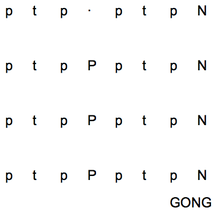Colotomy

Colotomy is a description of the rhythmic and metric patterns of gamelan music. It refers to the use of specific instruments to mark off nested time intervals, or the process of dividing rhythmic time into such nested cycles. In the gamelan, this is usually done by gongs of various sizes: the kempyang, ketuk, kempul, kenong, gong suwukan, and gong ageng. The fast-playing instruments, kempyang and ketuk, keep a regular beat. The larger gongs group together these hits into larger groupings, playing once per each grouping. The largest gong, the gong ageng, represents the largest time cycle and generally indicates that that section will be repeated, or the piece will move on to a new section.
The details of the rhythmic patterns depend on the colotomic structure (Javanese: bentuk), also known as gendhing structure. There are a number of different structures, which differ greatly in length and complexity; however, all of them have some colotomic characteristics.
In the gamelan, the instruments which articulate this structure are sometimes called the colotomic instruments (also interpunctuating instruments or structural instruments, while Lindsay refers to them as "phrase-making instruments"[2]). The Javanese names for these instruments are onomatopoeic, with the relative resonance of the words gong, kempul, kenong, and ketuk being comparable to that of the instruments they name.[3] In the system of cipher gamelan notation (kepatihan notation), the colotomic parts are notated as diacritical marks on the numbers used to show the core melody (balungan).
History and usage
The English language term was coined, presumably in Dutch,[4] from the Greek for a unit of rhythm (colon) and something that divides (-tomy/-tomic),[5] by the ethnomusicologist Jaap Kunst[6]
Although the term "colotomic" was derived from Indonesian music theory, it can be applied to other musical traditions as well. In particular, it has been used to describe Japanese gagaku and Thai piphat.[7]
Example of a colotomic structure
The lancaran is a cycle of 16 beats (keteg) in the following order:
- TWTN TPTN TPTN TPTG
where T indicates the strike of the ketuk, P the kempul, N the kenong, and G the simultaneous stroke of the gong and kenong. The W indicates the wela, the pause where the kempul is omitted. Thus, the gong plays once, the kenong divides that into four parts, the kempul divides each of those in two, and the ketuk divides each of those further in two. Note that except for the kenong playing on the gong, the instruments do not play when the next one plays. (Remember that the gatras of gamelan music have the strong beat (seleh) at the end, not at the beginning as is often considered normal for Western music. Thus the more important structural instruments coincide with the stressed beats.)
Colotomic structures occur on even larger scales in most gamelan pieces as well. For example, a typical lancaran has four gongs, at the end of which the larger gong ageng is played. Groupings of four are most common at all levels of structure, although there are numerous exceptions at larger levels.
The colotomic structure of a piece is the length of the cycle and how the interpunctuating instruments play during that cycle, but they are also musical forms which are associated with specific structural patterns on a larger scale than the colotomic cycle, and guidelines for what tempi and irama may be used.
Colotomic structures in Javanese gamelan
Most gendhing in Javanese music conform to one of these structures, except for some special ceremonial pieces and experimental new compositions.
From wayang
From the wayang repertoire, there are three common structures, listed here from shortest to longest:
- Sampak
- Srepeg
- Ayak-ayakan
Because wayang was originally performed exclusively in sléndro, pélog compositions in these structures are usually adaptations. These were originally written for wayang, but now appear in concert pieces.
General repertoire

T = kethuk, P = kempul, N = kenong, Gong = gong ageng.
There are four basic structures, listed from shortest to longest:
- Lancaran
- Ketawang
- Ladrang
- Gendhing
Note that gendhing can also mean gamelan pieces in general, but also has the specific meaning of a long structure. A single piece will often transition to other forms, especially to a shorter form. It is not unusual to perform a gendhing, a ladrang, a ketawang, and a lancaran, in that order, as a single piece, as long as they are in the same pathet.
See also
Notes
- ↑ Lindsay, Jennifer (1992). Javanese Gamelan, p.48-49. ISBN 0-19-588582-1.
- ↑ Lindsay (1992), p.10.
- ↑ Lindsay (1992), p.14.
- ↑ Pickvance, Richard (2005). A Gamelan Manual: A Player's Guide to the Central Javanese Gamelan, p.63. ISBN 9780955029509.
- ↑ Spiller, Henry (2004). Gamelan: The Traditional Sounds of Indonesia, Volume 1, p.69. ISBN 9781851095063.
- ↑ Malm, William P. (1977). Music Cultures of the Pacific, the Near East, and Asia, 2nd ed. Englewood Cliffs, NJ: Prentice Hall. Page 43.
- ↑ Malm, 123 and 194-195.
- ↑ Malm, William P. (1977). Music Cultures of the Pacific, the Near East, and Asia, 2nd ed., p.53. Englewood Cliffs, NJ: Prentice Hall. ISBN 0131823876.
External links
- Michael Tenzer. Excerpt from Balinese music describing colotomic structures in Balinese music (subscription required)

